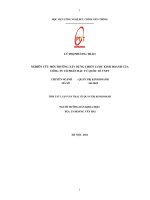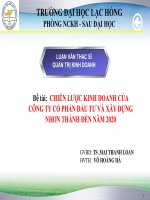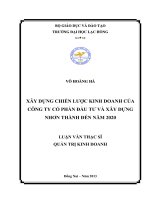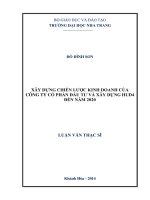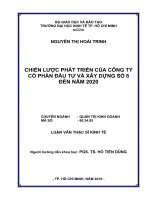Xây dựng chiến lược phát triển của công ty cổ phần đầu tư bất động sản ninh bình
Bạn đang xem bản rút gọn của tài liệu. Xem và tải ngay bản đầy đủ của tài liệu tại đây (420.39 KB, 75 trang )
LUẬN VĂN
XÂY DỰNG CHIẾN LƯỢC PHÁT TRIỂN CỦA CÔNG TY CỔ PHẦN ĐẦU
TƯ BẤT ĐỘNG SẢN NINH BÌNH
RESEARCH SUBJECT
MAKING DEVELOPMENT STRATEGY OF NINH BINH REAL
ESTATE INVESTMENT JOINT STOCK COMPANY
1
Hanoi, October 21st, 2009
TABLE OF CONTENT
page
INTRODUCTION …………………………….……………..
2
I. REASONS TO CHOOSE THE TOPIC …………………………….…………
2
II. PURPOSES AND RESEARCH QUESTIONS ………
3
2.1. Research matter …………………………….……………………...
3
2.2. Research question …………………………….…………………………..
3
II. REPORT STRUCTURE
……………...….……………
4
CHAPTER I - GENERAL THEORY OF PLANNING BUSINESS
STRATEGY OF ENTERPRISES
5
I. OVERVIEW OF BUSINESS STRATEGY …………...………
5
1. What is business strategy? …………………………….………………….
5
2. Meaningful features of business strategy? ………………………...
7
3. Meanings of business strategy toward enterprises ……..
8
3.1. Fiscal benefits …………………………….……………………………
8
3.2. Non-fiscal benefits …………………………….……………………...
8
II. SET AND CHOOSE BUSINESS STRATEGY OF ENTERPRISES
9
1. Strategy management process…………………………….………………...
9
1.1. Strategy formation process …………………………….……………
9
1.2.Strategy implementation process …………………………….………………
10
1.3. Strategy assessment process …………………………….……………...
11
2. Analysis of the business environment of the enterprise ………………..
13
2.1. Factors of the business environment …………………………….………
13
2.1.1.Macro-environment …………………………….……………………………
14
2
2.1.1.1. Economic factors …………………………….…………………………
16
2.1.1.2. Governmental and political factors …………………….………….
16
2.1.1.3. Social factors …………………………….………………………………
17
2.1.1.4. Natural factors …………………………….……………………………
17
2.1.1.5.Technology factors …………………………….…………………………
17
2.1.2. Operation environment …………………………….……………………..
18
2.1.2.1. Competitors …………………………….………………….
19
2.1.2.2. Customers …………………………….………………………………..
20
2.1.2.3. Suppliers …………………………….…………………………..
20
2.1.2.4. Potential competitors ……………………….…………………………...
21
2.1.2.5. Substitution products …………………………….………………………..
22
2.1.3. Internal environment …………………………….………………………….
22
2.1.3.1. Human resource factors …………………………….……………..
22
2.1.3.2. Development Research factors …………………………….…………..
23
2.1.3.3. Production factors …………………………….………………………
23
2.1.3.4. Fiscal-accounting factors …………………………….……………
24
2.1.3.5. Marketing factors …………………………….…………………………
24
2.1.3.6. Organizational discipline …………………………….
24
……………………………
2.2. Business environment analysis of enterprise
25
2.2.1. Information collection ……………………….………………………….
25
2.2.2. Planning summary …………………………….…………………………..
25
2.2.3. Planning reactive strategy…………………………….……………….
26
3. Some assessment models…………………………….……………………….
27
3.1. Assessment matrix of outer factors…………………………….……..
27
3.2. BCG matrix …………………………….…………………………………...
28
3.3. HOPER matrix…………………………….……………………………….
29
3.4- SWOT matrix …………………………….………………………………..
29
3
CHAPTER II - CORPORATE STRATEGY ANALYSIS FOR
NINH BINH REAL ESTATE INVESTMENT JOINT STOCK
COMPANY
I.
OVERVIEW OF NINH BINH REAL ESTATE INVESTMENT JOINT
STOCK COMPANY
31
31
1. History of foundation and development, function and tasks
31
2 . Organizational structure…………………………….……………..……
33
2.1.Current organizational outline…………………………….…………
33
2.2. Labor structure…………………………….………………………….
34
3. State of land and assets…………………………….……………….……..
35
4. State of business and production (2006 - 2008) ……….
36
II. CONFIRMATION OF MISSION AND VISION……………….……….
37
III. EXTERNAL ENVIRONMENT ANALYSIS ……………….………
38
3.1. Macro-environment analysis…………………………….………………
38
3.2. Sectoral environment analysis…………………………….………………
41
IV. INTERNAL ENVIRONMENT ANALYSIS
44
4.1. Advantages …………………………….………….
44
4.2. Disadvantages…………………………….…………
46
V. ANALYSIS OF STRATEGIC TARGETS……………….….…
50
VI. DETERMINATION OF STRATEGIC SELECTIONS……………….……
52
VII. ASSESSEMENT OF STRATEGIC SELECTIONS…………….…..
53
CHAPTER III. PROPOSAL OF CORPORATE BUSINESS
STRATEGY FOR THE COMPANY IN 2010-2013
55
I. CORPORATE STRATEGIC TARGETS FOR THE COMPANY
55
II. CORPORATE STRATEGIC METHODS OF THE COMPANY
60
1. General strategy…………………………….…………………………
60
2. Portfolio strategy…………………………….……………..
61
3. General administration strategy…………………………….……………..
61
III. SOME BASIC FUNCTIONAL STRATEGY METHODS TO SUCCEED IN
CORPORATE STRATEGY
62
4
1. Marketing …………………………….……………………………………..
62
2. Finance…………………………….………………………………………
63
3. Human resources…………………………….………………………………
64
4. Production…………………………….……………………………………….
64
5. Research & Development (R & D)…………………………….…………
64
IV. SOME PROPOSALS FOR SUCCESSFUL STRATEGY ORGANIZATION
65
CONCLUSION…………………………….………………………………………….
67
REFERENCES…………………………….………………………
68
5
ABBREVIATIONS
In this document, the abbreviations are understood as follow:
UBND
People’s Committee
BQL
Management Unit
TCCL
Quality Standard
TSCD
Fixed asset
TSLD
Working asset
BDS
Real estate
XN
Enterprise
DN
Business
DNNN
State company
DT
Investment
DV
Unit
CBCNV
Staff
QLNN
State management
6
INTRODUCTION
I. Reason for choosing the theme:
Vietnam’s economy is in the development momentum thanks to right
policies of the Party and Government in orienting development and managing
the economy, bravely abolishing old mechanism, creating an economy with its
own character, suiting conditions of the country. Vietnam is an official member
of the World Trade Organization, creating many challenges and opportunities
for domestic businesses. Businesses must recognize which opportunities that
need to be caught and which challenges that need to overcome in a multidimensional competitive world: “bigger fish eat smaller ones”. Over the last
time, we have realized clear influences of foreign economic organizations,
groups on our country’s economy. Foreign economic organizations, groups have
potentials in terms of capital, management competence and will become big
competitors of domestic businesses.
Although the State have intervened with economic policies for foreign
organizations to protect domestic businesses, integration roadmap in long-term
must base on inner strength of domestic businesses themselves, as joining
commitment is required to go according to a certain roadmap, the State cannot
intervene forever. Thus, the problem for businesses is how to build for themselves a
strategy to exist and develop. To solve this problem, businesses must have
intelligent coping ability to changes of the market, know to exploit their
advantages, understand their strong as well as weak points of competitors’, know
how to approach the market to find out about business opportunities and correct
way for themselves. Thus, businesses are absolutely necessary to build a long-term
development strategy for themselves.
7
Ninh Binh Real Estate Investment Joint Stock Company was established
according to License No. 4485/GP – TLDN dated March 06th, 2006 issued by
Ninh
Binh
Province
People’s
Committee.
Business
registration
No.
0364027/GPĐKKD dated March 12th, 2006 issued by Department of
Investment and was officially put into operation from March 15th, 2006. In the
past three years, the Company has built plans to orient its development in certain
periods. At the same time, it also met a lot of difficulties in 2008, when being
affected by global economic crisis. So far, standing in front of the process of
international integration, globalization, the application of short-term plans are no
longer suitable, it is required that the Company build strategy in accordance with
the requirement of developing business production in the new period.
The enterprise clearly determines the emphasis on the implementation of
investment in real estate business projects. This is a specific business with
extremely severe industry and business competition pressure, thus, building a
right strategy for the Company is very necessary.
Standing in front of such opportunities and challenges, making a clear,
correct strategy is the key factor, premise for the development and status
affirmation of the Company in the business world. This shows objective
necessity of the research of the theme: “Making business Strategy for Ninh Binh
Real Estate Investment Joint Stock company”.
II. Objective, issues and questions of research:
2.1. Issues need to be studied:
- Studying real state and result of the implementation of plans of the
Company in 2006, 2007, 2008.
- Making development Strategy of Ninh Binh Real Estate Investment Joint
Stock company in the period of 2010-2013.
8
2.2. Questions for study:
How was Ninh Binh Real Estate Investment Joint Stock company
established and how did it operate and develop? What are differences between
organizational structure and business professions of the Company and other
similar enterprises? What are business results of the company in three years
(2006, 2007, 2008)? What are opportunities and challenges, strong and weak
points of the Company? Mission and visibility of the Company? Strategic
objective of the Company? Determination of strategic choices? (Chapter 3)
What contents does the project of development strategy of the Company
for the period of 2010-2013 contain? Systems of controlling the strategy and
basic functional solutions to ensure the implementation of the development
strategy of the Company? (Chapter 4)
What are conclusions and petitions given to leaders of the Company,
sector and the Government? (Chapter 4).
III. Chapter structure of Report:
Chapter 1: Introduction
Chapter 2: General reasoning on business strategy making of the enterprise
Chapter 3: Analyzing business strategy for Ninh Binh Real Estate Investment
Joint Stock Company.
Chapter 4: Proposing business strategy for the Company for the period of
2010÷2013
9
CHAPTER I
GENERAL REASONING ON BUSINESS STRATEGY MAKING OF
THE ENTERPRISE
I. OVERVIEW OF BUSINESS STRATEGY
1. What is business strategy?
The term “strategy” originates from military art from the old days, it was
considered as the art directing means to win. Being borrowed from military
terms, the word “strategy” has been used quite commonly in economic life in
both macro and micro scale in which there are many notions on strategy such as:
- Strategy is the art of building firm competition advantages to defend
(M.Porter).
- Strategy is determination of ways and means to reach determined
objectives through policies (General Aileret).
- Strategy of enterprises is total decisions aiming to obtain important
positions, defend and create exploitation results which can be used immediately
(F.J.Gouillart).
- Strategy is the art of combining actions and controlling them to reach
long-term objectives (G.Hirsch).
- Strategy of enterprises is the outlining of firm and long-term
development orbits, we may arrange accurate decisions and actions of the
enterprise around those orbits. This is conception of Alain Charles Martinet,
author of the book “Strategy”, who was granted with big award of Havard I'
Expansion in 1983.
According to another approach, “Strategy” is a tool for enterprise to
answer questions: where do we want to go? Where can we go and how to go
there? What do we have? What do others have?
10
From some conceptions above, the term strategy contains and reflects
objectives of strategy, in the long-term time (3 years, 5 years, 10 years), the
process of making decision on strategy depends on competition environment
factor, advantage, weak points of the enterprise in general and according to each
activity in particular. So, we can see that the strategy of enterprise is a product
combining what the environment has, can do and expects.
Through the development of time, conceptions on strategy also changes
towards rising. Up to now, there are a lot of notions on business strategy,
however, two of them are considered to be common as follow:
- Business strategy is the plan of making and controlling business
activities of the enterprise including objective determination of business strategy
(3 years, 5 years, 10 years, etc); the process of making decision of the enterprise
and analysis of business climate; or in other words, business strategy is a
“product” which can combine what the environment has, can have and wants to
have. Thus, real nature of business strategy is the tool to reach long-term
objectives, and idea of business strategy aims at attacking to win victory in
competition and in the market.
- Business strategy is set of long-term objectives, big policies and
solutions about business production, finance and solving human factor to put
business activity of the enterprise to a new state of business activity which is
higher in terms of quality.
In short, business strategy is the art of organizing to combine optimally
resources, proposing and implementing decisions in conformability to changing
tendency of the environment to obtain success in competition to reach long-term
objectives in business.
2. Specific meaning of business strategy
From the above comception, we can clearly see basic features of business
strategy, which are:
11
- Business strategy must clearly determine basic objectives which need to
be obtained in each period and grasp thoroughly in every aspect, every level in
business production activity of the enterprise.
- Business strategy must ensure maximal mobilization and optimal
combination of exploitation and use of resources (human and tangible and
invisible assets). At present and in the future must uphold advantages, catch
opportunities to get advantages in competition.
- Business strategy of the enterprise is reflected in a whole continuous
process, from building strategy to implementing, evaluating, checking and
adjusting the strategy.
- Business strategy is built for implementation in a quite long time
(usually 3 years, 5 years, 10 years, etc).
With those features, it can be said that in market mechanism, the
construction, implementation of business strategy have particularly important
meaning to the existence and development of enterprise, as:
- It helps enterprise realize its objective, heading which is basis to
determine what tendency the enterprise must follow in business production and
when it can reach certain objectives.
- Changing of the market always creates opportunities and risks, building
strategy helps enterprise hold, take advantage of opportunities to overcome
risks, traps of the market.
- Building strategy creates firm basis for enterprise to propose decisions
suitable for the development of the market.
- Building and implementing strategy makes decisive contribution to
increasing efficiency of using resources, enhancing competition status, ensuring
sustainable development of the enterprise.
12
3. Necessity of business strategy to the enterprise.
3.1. Financial benefits
Studies show that if companies have good and clear strategies, they will
get high benefit and success in business. In practice, companies with good
results reflect a strategic orientation and emphasizes more on long-term.
Companies getting better financial results tend to plan systematically to make
preparation for future changes in inside and outside operating environment and
bring about outstanding financial results in their business profession.
3.2. Non-financial benefits
Strategy, in addition to show that companies get benefits as expected, can
avoid financial risks, also show other benefits. When having strategy, operation
of enterprise will go according to a clear direction, this easily brings about
success in business, high benefit, the first thing is to help the enterprise exist and
develop, pulling the stability in terms of politics, organization, relationships, etc;
specifically, increase efficiency, enhance prevention ability to difficulties of the
company. In addition, the success of strategy also brings about order and
discipline for the company. It may be the beginning of an effective
administration system, recovering belief in the current business strategy or
showing the necessity of having adjustment activity.
II. BUILDING AND CHOOSING BUSINESS STRATEGY OF THE
ENTERPRISE
1. The process of strategic administration
Administration conceptions have existed for a long time but until late 19th
century and early 20th century, administration theories consisting of ideas which
were arranged systematically and studied on the basis of scientific analysis
actually appeared, formed with administration school according to science,
quantity in accordance with competition requirement in modern business
activities.
13
Strategic administration is the process of studying the environment to
establish strategic objectives, policies and solution on business of the enterprise,
to organize to put strategy, business policies into practice to make decision on
adjusting, checking, evaluating the strategy and business policy implementation.
1.1. Strategy forming stage
Forming strategy is the process of setting up business tasks, implementing
research investigation to determine inside and outside factors, proposing longterm objectives and choosing alternative strategies. Sometimes the process of
forming strategy is called: “making strategy plan”. Strategy forming consists of
three basic activities:
- Carrying out study: related to collection and treatment of information on
markets and business professions of the company. This process is called
“considering perfunctorily business climate”. In nature, carrying out study is to
determine strong, important and weak points in functional business area.
Different investigation forms can also be developed and implemented to survey
inside factors such as staff’s spirit, production efficiency, advertising efficiency
and customers’ faith.
- Harmonizing intuition and analysis: some administrators and owners of
enterprises declare that they have special gift in using intuition when giving
excellent strategies. Although at present, some organizations can exist and
develop prosperously thanks to intuition geniuses in management, however, the
majority is not as luck as that. Most of organizations can make profit from
strategy on capital based on harmonious combination between intuition and
analysis in decision making.
- Making decision: as not any organization have limitless resources,
strategists are compulsory to make decisions related to selecting which
alternative strategy will bring about most benefit to the company. Decisions in
14
the process of forming strategy will fix organization to specific products,
markets, resources and technology in a long time.
1.2. Process of implementing strategy
Implementing strategy is often called action stage of strategy
administrators. Implementing means mobilizing administrators and staff to
implement established strategies. Basic activities of this stage are:
- Establishing annual abjectives: are landmarks that organizations must
reach to come to long-term objectives. It is a must that annual objectives can be
measured, have quantity, challenging, practical, conformable and are given
priority. These objectives are often proposed in company level, division and
function level in a big company. Annual objectives should be proposed under
the form of achievements on management, marketing, finance, accounting,
administration, information study and development. A series of annual
objectives is necessary for each long-term objective. Annual objectives are
particularly important in strategy, it is the basis for resources distribution.
- Policies: Policy is a tool to reach objective. Policy consists of
instructions, principles and procedures which are established to support efforts
to obtain set objectives. Policies are instructions for making decision and show
repeated or cycle situations. Policies, as anuual objective, are particularly
important in implementing strategy because thay can embrace expectations of
staff and administrators in the organization. Policies allow cooperation and
internal consistency between departments of the organizations.
- Distributing resources: distributing resources is a central administration
activity paying to the implementation of strategy. Strategy administration allows
resources to be distributed according to priorities which are established due to
annual objectives. There is nothing causing more harm to strategy
administration process and success of the organization when resources are
distributed in unsuitable ways to priorities pointed out by approved annual
15
objectives. All the organiations have at least 4 types of resources which can be
used to reach objective.
+ Financial resource
+ Material resource
+ Human resources
+ Technological technique resource
In short, the strategy implementing stage is considered as the most
difficult one. Implementation of strategy requires discipline, devotedness and
sacrifice of each individual. Success strategy implementation turns around staff
promotion ability of administrators, which is an art other than science. If
proposed strategy is not implemented, it will not serve any useful purpose.
1.3. Strategy evaluation stage.
Most of strategy makers agree that strategy evaluation is necessary to
reach prosperity of the organization, timely evaluations can alert administration
about difficulties before a situation become severe.
Sufficient, timely feedback is the basis of strategy evaluation which is not
different from current information. Too much pressure from leading
administrators can affect lower administrators in discovering data that they think
to be satisfied.
Although one or more strategies maybe right, this type of reasoning
maybe wrong as strategy evaluation includes both short term and long term
objectives. Stategies do not often affect short term operation result until too late
to make necessary changes. We cannot prove a typical strategy to be the best or
ensure that it can work. However, people can evaluate it through severe errors.
Richard Rumel recommends 4 standards to evaluate strategy, which are:
+ Consistency
+ Conformability
16
+ Advantage
+ Feasibility
Figure 1.1 Model of business strategy
administration
Feedback information
Implementin
g external
control to
determine
opportunitie
s and threats
Deter
minin
g
curren
t
missio
n,
object
ive
and
strate
gy
Establishing
short-term
objectives
Reviewing
business
objectives
Implementin
g external
control to
determine
opportunitie
s and threats
Establishing
short-term
objectives
Distributing
production
resources
Choosing
strategies
Chec
king
and
evalu
ating
Proposing
policies
2. Analyzing business climate of the enterprise
2.1. Business climate factors
Good strategy management depends much on the understanding of
environment conditions that the enterprise is facing. Environment factors have
deep influence as they affect total subsequent steps of the strategy management
process. Final strategy must be made on the basis of anticipated environment
conditions.
17
General environment that the enterprise faces can be divided into three
levels: macro environment, operational environment and internal circumstance.
Macro environment affects all the business professions, but not absolutely
necessary in a certain way. Operational environment is determined to a certain
industry, to all firms in the sector being affected by operational environment in
that industry. Many times macro and operational environment combine to each
other and is called external environment or environment beyond control of the
company. Internal circumstance consists of immanent factors in a certain
enterprise. In practice, enterprise is the synthesis of its internal circumstance
factors. Sometimes internal circumstance is called internal environment or
controllable environment. Macro environment contains factors lying outside
organization, shapes and has influences on operational and internal
environments, creating opportunities and risks to the organization.
Operational environment consists of factors outside the organization,
orienting competition in the sector.
Internal circumstance contains internal resources of the organization.
2.1.1. Macro environment
Figure 1.2 Business climate elements
Competitors
Econo
my
Suppli
er
Techn
ology
Enterp
rise
Alternative
products
Institution
&
legislation
Custo
mers
Societ
y
Nature and
environment
18
Analyzing macro environment helps enterprise partially answer the
question: what is enterprise facing?
Although many different matters of macro environment can be discussed,
we choose matters mentioned in table 1.1: economic factor, governmental and
political factor, social factor, natural and technological factor. Table 2 will give
specific examples on factors that we choose. Each factor of macro environment
above can affect the enterprise independently or in a link to other factors.
Table 1.1. Macro environment factors
Economic
factor
Political and
governmenta
l factor
Social factor
Natural
factor
Technologica
l factor
Stages in
economic
cycle
Regulations
on lending
customers for
consumption
Viewpoint
about living
standard
Environmenta
l pollution
Cost for
research and
development
from NSNN
Money
funding
source
Regulations
on antimonopoly
Life style
Energy
deficiency
Cost for
research and
development
in the sector
Tendency of
GNP
Laws on
environmental
protection
Female
laborers
Natural
resources
waste
Focus of
technological
efforts
Inflation rate
Decree-laws
on tax
Aspiration
about career
Copyright
protection
Bank interest
Regulations in
foreign trade
area
Consumption
positiveness
New
technology
transfer
Currency
policy
Special
behavior
regulations
Birth rate
New products
19
Unemployme
nt rate
Financial
policy
Regulations Population
on
increase rate
employment
and promotion
Stability
degree of
government
Population
displacement
Human,
machine use
automatics
Price, pay
control
Balance of
payment
2.1.1.1. Economic factors
Economic factors have extremely big influences on business enterprises
Major economic influences factors such as bank interest, stage of
economic cycle, balance of payment, financial and currency policy. As these
factors are relatively large, enterprises need to select to identify certain
influences that will affect them most directly. Each of economic factors above
may be opportunity or risk.
2.1.1.2. Governmental and political factor
Governmental and political factors have bigger and bigger influences on
operation of enterprises. Enterprises must conform to regulations on tax,
lending, insurance, advertising, factory location and environmental protection.
Meanwhile, operation of the Government can also create opportunities or risks.
For example, some programs of the Government (such as tariff of competitive
foreign goods, tax exemption policy) create growth or existence opportunity for
enterprises. In contrast, tax increasing in certain industries (such as electronic
game) can threaten profits of the enterprise.
20
2.1.1.3. Social factor
Enterprises need to analyze extensively social factors to identify possible
opportunities and risks. When one or more factors change, they can affect
enterprises such as: human racism tendency, entertainment taste, ethical
standard and conception on life style, business community and female laborers.
Sociology factors above often change or develop slowly, thus, sometimes
it is difficult to identify them. Other changes develop faster if they are caused by
any external interruption in social ethical behavior and standard.
2.1.1.4. Natural factors
Influences of natural conditions to policy making have been recognized
by enterprises for a long time. However, to now, factors about remaining natural
environment are hardly paid attention to. Attention of enterprises through
business policy-making increases more and more as the public care more about
the quality of natural environment.
2.1.1.5. Technological
Figurefactors
1.3 Relationship between factors in operational
environment
There are few industries and enterprises not depending on technological
basis that becoming more and
Surely, more advanced
New more
implicitsophisticated.
competitors
technologies are coming into being, creating opportunities as well as risks to all
Risk
of having new
the industries and certain enterprises. Leading
technology
development research
competitors
and transfer in general are rushing to study new technical solutions to solve
in the sector
problems and determine currentCompetitors
technologies
that can be exploited in the market.
Price squeeze
Price squeeze
capacity of the
buyer
2.1.2. Operational
environment
capacity
of good
s supplier
Operational
environment consists of factors in the sector and
Supplier
Buyerthat are
surroundings factors to the enterprise, deciding the competition nature and level
Competition
in that business. There are 5 basic
factors between
whose relationships are reflected on
following figure:
existing enterprises in
the sector
Risk due to alternative
products and services
Alternative products
21
As the general influence of these factors is often real reluctance to all
enterprises, the key to propose a successful strategy is to analyze each of those
main factors. Understanding of competition pressure sources helps enterprise
identify its strong and weak points related to opportunities and risks that the
business faces.
2.1.2.1. Competitors
Understanding of competitors has a special meaning to enterprises due to
many reasons. Firstly, competitors decide the nature and level of competition or
skill of gaining advantages in the sector depending on competitors. Fierce
competition level depends on the interaction between factors such as the number
of enterprises joining the competition, the growth level of the sector, fixed
expense structure and level of goods diversification. The existence of these
22
factors tends to increase demand or expectation of enterprises to get and protect
their market share. Thus, they make competition more severe. Enterprises need
to recognize that competition process is not stable. In addition, new competitors
and technological solutions often make competition level and nature change.
Enterprises need to analyze each competitor to understand reaction
measures and actions that they can approve. The major parts of analysis of
competitors reflect in the following figure:
Figure 1.4. Analyzing competitors
What does the
competitor want to
gain?
What is the competitor
doing and can do?
Some matters need to be
answered about competitor
Future
purpose
All the
multidimension
al management
levels
Judging
Its influences on
industry
- Does the competitor agree to
current position?
- What is the capacity of
competitor?
- - What are weak points of the
competitor?
- What can help the competitor
retaliate most strongly and
effectively?
Current
strategy
At present, how
is the enterprise
competing?
Potentials
Strong and
weak aspects
2.1.2.2. Customers.
Customer issue is an inseparable matter in competition environment.
Trust of customers is the most valuable property. That trust is gained as
23
enterprise knows to satisfy customers’ demand better than competitors do.
Another key matter is bargaining capacity of customers. Buyers can make
profits of the sector decrease by squeezing price or ask for higher quality and
must do more service job.
2.1.2.3. Supplier.
Business enterprises need to have connection to supply organizations of
different goods such as materials, equipment, labor and finance.
- Materials and equipment supplier
Materials, equipment-supplying organizations having advantage
can “press” profits by reducing quality of the product or accompanied service
degree. Factor that can increase the strength of supplying organizations is
similar to factors increasing strength of product buyers. Specifically:
+ Number of suppliers is few
+ There is no alternative product
+ There is no supplier ordering different products
Choosing supplier bases on analysis data of the seller. Need to analyze
each supplying organization according to factors having important meaning to
each enterprise. In certain times, most of enterprises, even effective enterprises
have to lend capital temporarily from financial community. This source can be
lent in short term or long term or issued in stock. When enterprises carry out
analysis of financial community, firstly they need to pay attention to
determining their status compared with other members in the community.
Labor source is a main part on the competition environment of
enterprise. Ability of attracting and holding competent employees is premise to
ensure success for enterprise. The main factors that need evaluating are labor
ally, including training and professional qualification, relative attraction level of
enterprise as labor and common salary user.
24
2.1.2.4. Implicit competitor.
New competitors joining business in the sector maybe the factor reducing
benefits of the enterprise as they exploit new production capacities, with desire
of gaining market share and necessary resources. It is necessary to notice that
the acquisition of other establishments in the sector with the intention of
building market part is often the expression of appearing new competitors.
Although not every time the enterprise meets new implicit competitors, the risk
that new competitor integrate into the sector is affected and has influences on
the strategy of the enterprise. A barrier preventing the penetration of newly
implicit competitors is the strong resistance of the enterprises which are standing
firmly.
2.1.2.5. Alternative product.
Pressure as alternative product limits the profit potential of the sector as
the sector has controlled high price. If we do not pay attention to implicit
alternative products, enterprise maybe dropped back with small market share.
Thus, enterprises need to continuously study and check implicit alternative
commodities. Most of new alternative products are results of technological
explosion. To gain success, enterprises need to pay attention and spend
resources to develop or apply new technologies in their strategy.
2.1.3. Internal environment
Internal environment of enterprises consists of all internal factors and
systems of enterprises. Enterprises must try to analyze carefully those internal
factors to reduce weak points and uphold strong points to get maximal
advantages. Internal factors include:
- Human resources
- Studying and developing production
- Financial accounting
25
